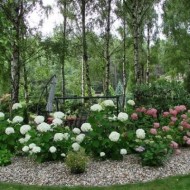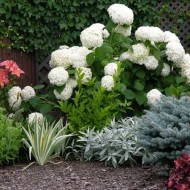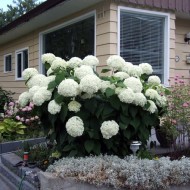We grow hydrangea Anabel in the country: tips for beginners and experienced gardeners
Content
- 1 History and description of hydrangea Anabel
- 2 Video "How to care for hydrangea"
- 3 Varieties of hydrangea Anabel with a photo
- 4 Advantages and disadvantages of the variety
- 5 Features of growing tree hydrangea Anabel
- 6 Potential diseases and pests
- 7 The use of hydrangea Anabel in garden design
- 8 Reviews of summer residents
History and description of hydrangea Anabel
In the wild, the most beautiful tree hydrangea was discovered in the American state of Ohio in the middle of the 18th century. The flowering plant was so beautiful that it was moved to the GulfStream nursery and given a very delicate name - Annabelle (Hydrangea arborescens Annabelle). In American nurseries, this hydrangea has been actively cultivated since the 70s of the 19th century. Once in Europe, the flowering shrub immediately gained incredible popularity, and in the UK it was awarded the prestigious award of the Royal Society of Gardeners.
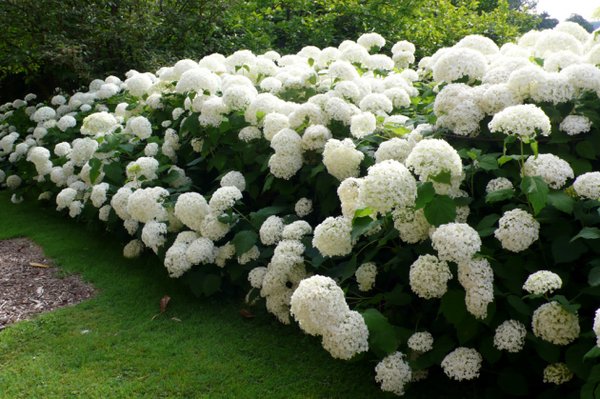
The Anabel variety is a low, deciduous, dome-shaped shrub. Its height rarely reaches 1.5 m. Usually, the crown is formed at the level of half a meter, without pruning, the shoots can grow up to 3 m. The leaves are large, pointed at the end and uneven at the edges, 15-20 cm long, remain saturated green until the very frost.
The description of flowers deserves special attention. They bloom at the end of June and only fade in October. The flowers themselves are small (up to 2 cm), 4-petal, collected in lush spherical inflorescences up to 20 cm in diameter, cover the entire bush. At the beginning of their flowering, they have a greenish tint, then acquire a snow-white color.
Hydrangeas begin to bloom at the age of 3-4 years, but this often happens with young seedlings in the year of planting. The plant is characterized by rapid development - in a year the shoots grow by 20 cm. The life cycle in good conditions is 40-50 years. The winter hardiness of hydrangeas is quite high - the culture can withstand frosts down to -35 ° C.
Video "How to care for hydrangea"
In this video, an expert will tell you how to properly care for a hydrangea, plant and prune a plant.
Varieties of hydrangea Anabel with photo
The culture has several varietal varieties, differing in the color of foliage and inflorescences:
Pink annebelle
Tall shrub (up to 1, 2 m) with large pinkish inflorescences. Among the treelike hydrangeas, this is the first and only pink variety. The buds of the Pink variety are dense and stick tightly to the umbrellas, they are removed by hand, since they themselves do not crumble. The shoots are thin, bend under the weight of the inflorescences and require a garter.
Unlike other hydrangeas, Pink prefers alkaline soil, tolerates drought well, but is afraid of wind and drafts.
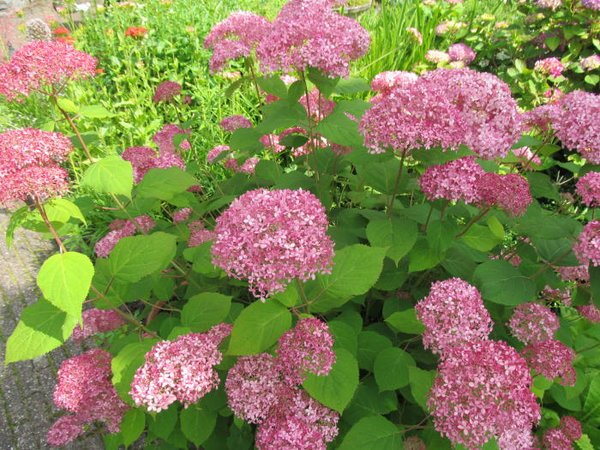
Golden annebelle
It is a variegated hybrid form. The plant looks very impressive: the leaves are colored irregularly, light green stripes alternate with creamy yellow, large inflorescences (up to 25 cm) of a delicate cream shade. The Golden hydrangea bush is tall, up to 1.5 m in height, and the same in width. Blooms from July to late August.
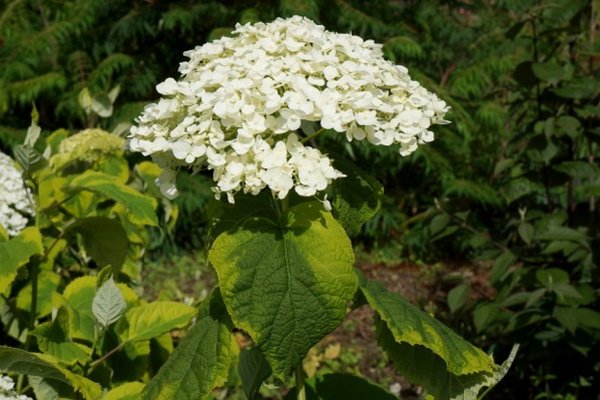
Strong annebelle
The Strong variety blooms with the largest snow-white inflorescences, densely covering the entire bush. She prefers acidic soil and needs constant feeding. Blooming umbrellas are great for cutting and are often used in wedding bouquets.
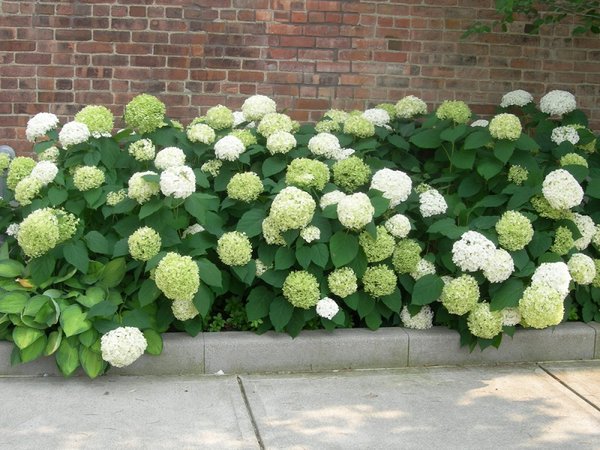
Advantages and disadvantages of the variety
- decorative throughout the season;
- the crown is compact, easy to form;
- long flowering (from June to the very frost);
- beauty and delicate aroma of inflorescences;
- high growth of shoots;
- good winter hardiness and immunity to a number of diseases;
- long-term viability of the bush (up to 50 years);
- an abundance of root shoots that can be used for reproduction.
- exactingness to the soil;
- increased need for pruning and feeding.
Features of growing tree hydrangea Anabel
The plant is well adapted to any conditions, but in order for it to retain its decorative appearance, some features of agricultural technology should be taken into account.
Planting recommendations
Planting hydrangeas is carried out in the fall or early spring. They need a lot of heat and light to bloom, so the site should be open and calm. They also love moist soils, although they can tolerate short-term drought. As far as the soil is concerned, it should be well-drained and fertile, slightly acidic with a pH level of about 5.
An optimally suitable soil mixture can be made from garden soil, humus, sand and peat in a ratio of 2: 2: 1: 1. This mixture is used to fill the planting pits by a third, then a seedling is placed there so that the root collar is flush with the surface, and gently fall asleep with earth. After planting, the plant must be watered abundantly.
Dig holes for hydrangeas are small, about 30 cm deep and the same in diameter. They should be placed at a distance of 1 m from each other. For planting, it is better to select seedlings 2-3 years old - they have a higher survival rate.
The nuances of care
The main care of the crop is watering, fertilizing, pruning and loosening the soil. To avoid the appearance of weeds and to maintain decorativeness, the soil around the bush is mulched with straw, sawdust, and wood chips. Loosening is carried out 2-3 times a season, each time the mulch should be added or replaced.
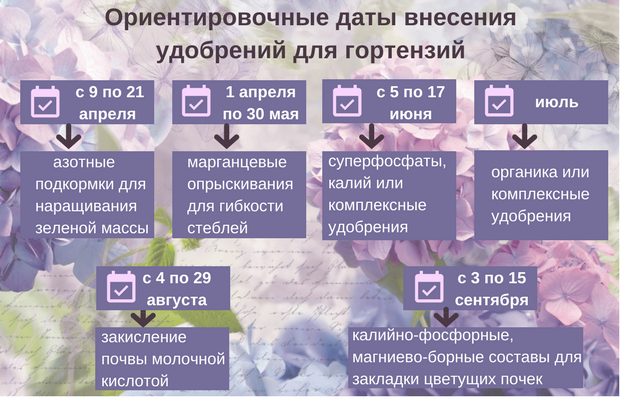
Watering is done as the soil dries up. Once a month, for the strength of the shoots, it is recommended to water the hydrangea with a weak solution of potassium permanganate. The bushes are very responsive to feeding, several of them are carried out per season:
- in April - a nitrogen complex with microelements;
- at the end of May - treatment of the crown with manganese to increase the flexibility of the shoots;
- at the beginning of June (the time when the buds are laid) - a complex with potassium and phosphates;
- in July-August (period of active flowering) - a little organic matter in the form of liquid manure, herbal infusion;
- September - a potassium solution with trace elements for laying flower buds.
Hydrangeas do not need special preparation for winter. For adult bushes, it is enough to carry out sanitary pruning, remove all the foliage, huddle the roots or sprinkle them with mulch. Young seedlings in the first year require a more reliable frame shelter.
Potential diseases and pests
The resistance of hydrangeas to diseases and pests is quite high. In rare cases, it can be affected by:
- powdery mildew - the crown needs to be sprayed several times with a copper-containing fungicide and make sure that the bush is regularly ventilated;
- gray rot - treatment also consists in treating the bush with a fungicide, diseased shoots are cut out and destroyed;
- chlorosis - the disease is manifested by yellowing of the leaves due to a lack of iron and alkalization of the soil.For treatment, fertilizing with a mineral complex with trace elements is used.
Hydrangea pests can harm:
- leaf aphid - the bush is treated with an insecticide, garlic or tobacco infusion;
- at high humidity, slugs may appear - they must be collected by hand, and also monitor the air exchange in the crown.
The use of hydrangea Anabel in garden design
Hydrangea bushes are beautiful on their own, so they are often planted individually or in groups as hedges, borders, along garden paths, along the banks of artificial reservoirs. The main requirement is good illumination of the place.
In combination with other plants, flowers look good too. Flowering low-growing shrubs with a round crown will ideally complement mixborders, in mixed compositions they will highlight bright crops. The white color goes well with the emerald green of the lawn, undersized conifers and ferns.
- The white color goes well with the emerald green of the lawn
- Anabel's hydrangeas look good in a group with other plants
- Anabel hydrangeas are planted in well-lit areas
Reviews of summer residents
“A very beautiful plant with abundant flowering, but it needs the right soil to be that way. If the acidity is not right, it will not show itself in all its glory. "
“A whimsical bush, something was missing all the time. In general, I suffered while I learned to take care of him, but now I have been enjoying flowering for 5 years. "
“I want to plant such shrubs in my dacha. They are short, I think they will look good at the entrance. "
This hydrangea variety is ideal for maintaining a stable and well-groomed area. The shrub is able to bloom for decades without requiring much attention, looks elegant and creates a unique atmosphere on the site.

